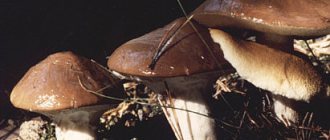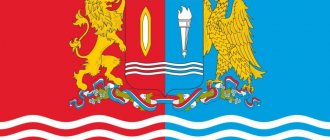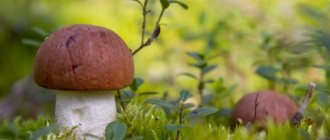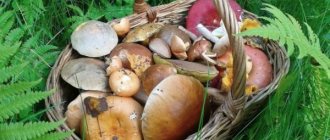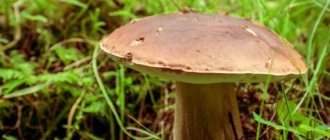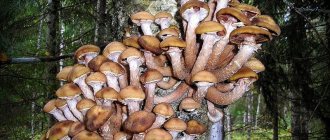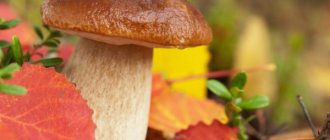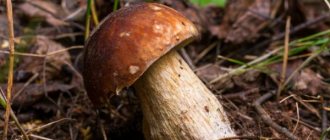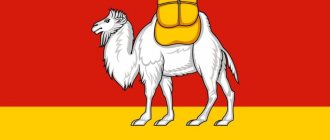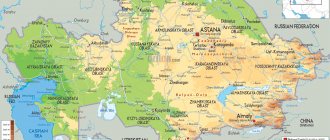Mushrooms
0
1337
Article rating
Kira Stoletova
About 150-200 species of mushrooms grow in the Udmurt Republic. However, mushroom pickers collect only common 8-10 species. Mushrooms of Udmurtia have long attracted the attention of fans of “silent hunting”.
Mushrooms in Udmurtia
Edible
In the coniferous, deciduous and mixed forests of the Udmurt region there are quite enough diverse types of edible mushrooms to avoid dangerous checks. Below we will discuss the most valuable and common of them.
Porcini.
Porcini
It is often called the “mushroom king” or “boletus mushroom”. Has a strong light leg. The spherical cap can have a color range from light beige to dark brown. On the underside of the cap there is a white or cream-colored sponge.
The body of the mushroom does not darken when broken or cut, as with any type of heat treatment. That is why the mushroom is called “white”.
Boletus
Boletus is red-brown.
People often call it “redhead”. It has a strong white leg with black speckles. The color of the sponge cap can take on different shades of red depending on the location and growing conditions.
The cut site almost immediately acquires a bluish tint. In false boletus, the stem turns pink or red when cut.
boletus
Boletus.
Like “red”, it belongs to the family of obobs. It differs from the boletus not only in its favorite tree, under which it hides, but also in its elongated leg with a black mesh. The color palette of the spongy cap can vary from light beige to dark brown.
Real boletus does not change color when cut or broken. The false mushroom has an off-white or pink sponge, and its cap has a gray or pinkish tint.
Dubovik
An inexperienced mushroom picker may confuse it with a white or even a satanic mushroom. But the oak tree has a red leg, and the cap has a velvety lemon-colored surface. When cut, the flesh turns blue, while that of the satanic mushroom turns yellow or takes on a creamy tint.
1- Olive-brown oak. 2-Speckled oakwood.
Chanterelles
Chanterelle.
A rather rare mushroom for Udmurtia. It has a short stem that turns into a concave cap with wavy edges with the help of many characteristic plates. Real chanterelle is yellow or orange in color and does not change when cut. Whereas the false chanterelle has a much more pronounced red tint, and when broken, it releases white juice.
Butter
A yellow-brown mushroom with a characteristic cap that has an oily top and a yellow, spongy bottom. The film covering the top is very elastic when removed. The false butterdish has not a sponge on the back of the cap, but plates; the skin does not stretch, and the mushroom itself has a distinct purple tint. It turns red when cut.
Ordinary oiler.
Mokhoviki
In full accordance with the name, it prefers to grow on mosses. It has a dense yellowish leg. The convex velvety cap can range in color from burgundy to dark green. On the reverse side there is a bright yellow sponge.
1- Variegated flywheel. 2- Moss fly green.
Champignon
It has a beige or cream color. The round cap almost completely envelops the leg. On the reverse side there are dark brown plates covered with a film skirt. Grows in relatively dry clearings and forest edges.
1- Two-ringed champignon. 2- Common champignon.
Honey mushrooms
Mushrooms of this species grow in families on stumps, roots and tree trunks. The caps are cream or light brown in color and decorated with darker scales. There is a skirt on the stem of these lamellar mushrooms. False mushrooms do not have such a film ring, and their color is brighter.
1-Meadow honey agaric. 2-Autumn honey fungus.
Russula birch.
Russula
Young mushrooms of this family, which grow almost everywhere, have a spherical cap, which flattens over time and even takes the form of a saucer. The structure of the mushroom is dry and very fragile, the plates on the back of the cap are frequent and white or yellow.
At the same time, the white leg changes shade. The color of the cap can vary from green to red. But purple or dazzling red color indicates an inedible double.
Meadow raincoat.
Raincoat
Popularly it is also called “hare potato”, “porkhovka” and others. This is a mushroom of a specific spherical shape with an ultra-short stalk.
The pulp has a white or beige color that does not change when cut. False puffball is distinguished by its dark skin, purple flesh and yellow or green cut color.
Saffron milk caps
It grows mainly near pines and larches. As the mushroom grows, its sticky, plate-like cap becomes funnel-shaped. The color can be red, orange or blue-green. The cut area gradually takes on a green color.
1-Rizhik red. 2-Rizhik is real.
Volnushki
It has a dense tubular stem and a flat pink cap with a depression in the center. The pulp and juice are white when cut; their color does not change over time. Inedible flakes have a greenish tint to the cap, different from the white color of the flesh, and dark scales.
Pink wave.
Cobweb
The second name of this mushroom is “swampweed”. It has a bright yellow color, a regular round cap and an ideal frequent radial arrangement of plates. False cobwebs have irregular shapes, pale colors, an abundance of scales and an unpleasant swampy odor.
1-Cobweb is slimy. 2-Mucous cobweb. 3-Cobweb staining.
Oyster mushroom.
Oyster mushrooms
They grow on trees in families, located under each other, which is why they got their name. They have a smooth (less often wavy) cap and a gray color with a purple tint. The leg is short and dense
In the forests of Udmurtia you can find other, more exotic edible mushrooms. But only specialists and very experienced mushroom pickers can accurately identify them and not confuse them with species harmful to health.
A pretty penny for the poor
“Strawberries and blueberries are a success these days,” says Tamara Poltanova, a pensioner from Kizner. “I planned to freeze them for the winter, but the refrigerator broke down.” There is not enough pension for new equipment. Therefore, the first berries had to be sold. Neighbors bought them, then others ordered them. I was able to put aside a small amount - I hoped to save up for a refrigerator. And then they announced a ban on visiting forests. Now I’m afraid to go into the forest - I’ll be fined. I heard that there will be patrols and a checkpoint with a barrier at the entrance to the forest.”
Collecting forest gifts has long brought an extra penny to low-income families or has become the main condition for survival. Those people in the countryside who cannot afford food in the store get it without making financial transactions. For example, they collect wild berries, stocking up on vitamins for free. Or medicinal herbs to minimize medical costs.
About 10-15 years ago, a mother of thirteen children from the village. Pychas, Mozhginsky district, Tatyana Kadrova admitted that she buys school supplies for children with money raised from the sale of berries and mushrooms. “Forest” money constantly helps out pensioners who are not aware that, in accordance with Art. 11 of the Forest Code, the collection of wild plants was allowed exclusively for personal consumption.
“The new forest legislation does not create problems for the population now. On the territory of our municipality live several low-income families who pick mushrooms and berries for sale,” explains the head of the Volipelginskoe municipality of the Vavozhsky district, Alexander Kuzmin. “No one is putting any obstacles in their way.” And selling one or two liters of berries cannot be called a big crime. Cranberry harvesting cooperatives operate in neighboring areas. But in our forests there are no resources for harvesting on an industrial scale.”
Literally a week before the ban on visiting forests, Udmurtstat reported that every eighth resident of the republic had incomes below the subsistence level. And the number of beggars, despite the loud statements of officials about the fight against poverty, is growing. In 2012, 11% of the population was below the subsistence level.
However, according to forecasts by officials from the Ministry of Natural Resources, with the beginning of the collection and processing of forest non-timber resources, the rural population may have additional income. People will hand over the collected mushrooms and berries to the harvesters. From now on, will a young mother be able to bring a glass of strawberries from the forest for her child?
Recently, a tenant of 43 thousand hectares of forests in the Balezinsky district appeared. For 49 years, the entrepreneur will harvest the birch chaga mushroom, carry out all the necessary work to restore the forest and annually pay more than three million rubles to budgets of various levels.
“An entrepreneur has no right to impose any restrictions on visiting the forest fund,” assured Minister of Natural Resources Denis Udalov.
Mushroom and berry pickers are no competition for chaga harvesters. And the entrepreneur who will rent forests for subsequent berry picking will also be welcoming to people with baskets? It is clear that the tenant, who is obliged to carry out reforestation work and pay taxes, will claim the main role of the harvester.
Inedible
In addition to edible ones, a large number of inedible or, as mycologists call them, “conditionally edible” mushrooms grow in the Udmurt region. They either require repeated heat treatment, are completely inedible, or are potentially dangerous.
Such mushrooms do not have any special nutritional value and are collected only when you don’t want to return from the forest with empty baskets. In all other cases, the saying “the game is not worth the candle” is true.
The main differences between the false twins of edible mushrooms are given in the descriptions of them in the previous section. In addition to them, numerous forests of Udmurtia also store other types of inedible mushrooms. Here are just some of the most common ones:
- umbrellas , so nicknamed for the characteristic shape of the mushroom;
- pigs , which have an external resemblance to volnushki;
- most types of milk mushrooms , which tend to accumulate toxins;
- talkers;
- rows;
- lines;
- chaga and other varieties of tree mushrooms.
tineoenvertical_linares
In order not to damage your own health, or harm your relatives and others, it is best to be guided by the golden principle of the mushroom picker “if you don’t know, don’t take it!” The types of mushrooms listed in the “Edible” section are quite enough for both a feast and homemade preparations.
We must not forget that more than 20 species of mushrooms found in local forests are listed in the Red Book. It is not only forbidden to collect them. Even unintentionally causing harm to them may entail administrative liability!
Features of searching for mushrooms
The forests of Udmurtia will delight you with harvest
You will also be able to reap a rich harvest if you use mushrooms as a guide. You can always pick boletus mushrooms in the southern part of Udmurtia. It’s easy to collect porcini mushrooms – they grow not just alone, but as a whole family. They follow him to the pine forests near the Chur station.
Saffron milk caps prefer spruce and pine forests where fir and cedar trees grow. Mushroom pickers especially love to collect them because... fruiting bodies always grow in a whole group. Close to Izhevsk is the village of Selychka, where people most often go to get them.
Honey mushrooms love fallen trees; sometimes one of them grows so many mushrooms that it will be possible to fill a whole basket. They are found in the same places where they were collected a year ago. Butterflies abound in areas near the Votkinsk tract, near the villages of Venya and Yuski. For Gruzdy they go to floodplain forests along the Shaberdinsky tract.
Poisonous
The real danger to human health and even life is posed by poisonous varieties of mushrooms, of which there are many hidden in the forests of the Udmurt Republic. Here is a list of the most common ones:
- all types of fly agarics ;
- absolutely all varieties of pale grebes ;
- satanic mushroom;
- almost the entire family of talkers;
- greenfinches.
houbofka
slawek_magier
bo_diesel78
natalya_chukavova
antoniotopsy
And all kinds of false mushrooms. How to distinguish them from real ones is briefly indicated in the descriptions of edible species. Here the golden principle of the mushroom picker, which was mentioned above, acquires utmost relevance and vital importance! However, before going to the forest to pick mushrooms, it would be a good idea to study or refresh your knowledge about the most dangerous of them.
Precautionary measures
To ensure that the collected forest fruits do not cause harm, the following rules must be followed when collecting them:
- You should not take specimens of which there is even the slightest doubt about their edibility; it is not recommended to cut off old mushrooms - they are capable of concentrating a lot of harmful substances;
- It is undesirable to use plastic, metal containers or bags, as they suffocate the crop; it is better to put it in a ventilated basket made of natural material;
- You should not collect edible species that grow along busy roads, highways and near industrial facilities; they contain large amounts of toxins, which they intensively absorb from the environment;
- immediately after collection, the product must be cleaned, washed and processed;
- When the first symptoms of poisoning appear, you should immediately seek qualified medical help.
In the forests of the central zone, in the mountains of Kamchatka and on the Kola Peninsula, in the forest belts of the North Caucasus and the famous steppes of Kazakhstan, in the regions of Central Asia, more than 300 species of edible mushrooms grow, which lovers of “silent hunting” love to collect.
Indeed, the activity is very exciting and interesting, which also allows you to feast on the harvest. However, you need to know about mushrooms so that poisonous ones do not end up in the basket along with edible ones, which, if eaten, can cause severe food poisoning. Edible mushrooms with photos, names and descriptions are offered for review by anyone interested in collecting mushrooms.
Mushroom places of Udmurtia
The Udmurt region is famous for its abundance of forests. They vary in their composition, density and soil structure. According to reviews from experienced mushroom pickers, the most fertile places for “quiet hunting” for the most valuable mushrooms are the following:
- For lovers of saffron milk caps and chanterelles , we can recommend the Zavyalovsky and Sharkansky districts; white ones ;
- purposefully go to Malopurginsky for saffron milk caps ;
- for chanterelles ;
- hunters for “noble” varieties ( boletus , boletus , boletus , white ), as well as connoisseurs of oyster mushrooms , boletus and moss mushrooms should follow the Yakshur-Bodino direction;
- Beginners and those who want to pick up a full basket of assorted mushrooms will happily await the vast forests of the Votkinsk region.
Of course, this list is far from complete. Every mushroom picker knows his secret and favorite places.
Flag of Udmurtia.
Benefits and beneficial properties of honey mushrooms
Honey mushrooms are one of the most beloved and popular mushrooms; they got their name because of the place where they grow. Honey mushrooms grow around stumps, they are also called “honey mushrooms”. It is also noteworthy that these mushrooms are “family members”, that is, they grow not singly, but in entire colonies; near one stump you can immediately pick a whole basket of mushrooms.
Getting to know their biochemical composition will help you appreciate all the health benefits of honey mushrooms. These mushrooms contain a large amount of vitamins:
Natural sugars, fiber, valuable amino acids, and ash are also present. In terms of phosphorus and calcium content, honey mushrooms can compete with fish.
Collection by month
Whatever the vagaries of the weather, Udmurt mushroom pickers begin the season with the onset of spring warmth and end it in late autumn.
| months | appear |
| April May | morels, puffballs, oyster mushrooms, honey mushrooms |
| June | boletus, boletus, fly mushroom, russula |
| July | white, boletus, champignons, chanterelles |
| Aug. Sept | trumpets, edible milk mushrooms, mushrooms “for pickling” |
The table provided is conditional, since in each specific season the weather conditions for mushroom growth may or may not be favorable.
Where to collect saffron milk caps in the Sverdlovsk region
Experts have divided the Sverdlovsk region into 3 conventional mushroom zones:
- In the mountainous area in the western part of the Ivdel region there are dry forests, in which, in addition to saffron milk caps, there are boletus, chanterelles and honey mushrooms.
- The wettest forests richest in mushrooms are located in the swampy area: the eastern part of the Ivdelsky district, as well as the Serovsky, Taborinsky, Garinsky and Novolyalinsky districts.
In the forest-steppe zones there are mixed, as well as birch forests and copses. However, here mushrooms are collected only after heavy rains. The forest-steppe zone covers several districts: Achitsky, Artinsky, Nizhneserginsky, Kamensky, Kamyshlovsky, Tugulymsky and Bogdanovichevsky.
The climatic weather conditions of the region are very favorable for the growth of many types of fruiting bodies. In the forests you can collect a rich harvest of mushrooms and provide yourself and your family with supplies for the whole winter. For example, saffron milk caps are also collected in the vicinity of Yekaterinburg. Leaving the city in any direction, you can get into the forest and not only take a break from the bustle of the city, but also quietly “hunt.” The main thing is to get away from highways and roadside dumps.
Ryzhiki in the Sverdlovsk region.
